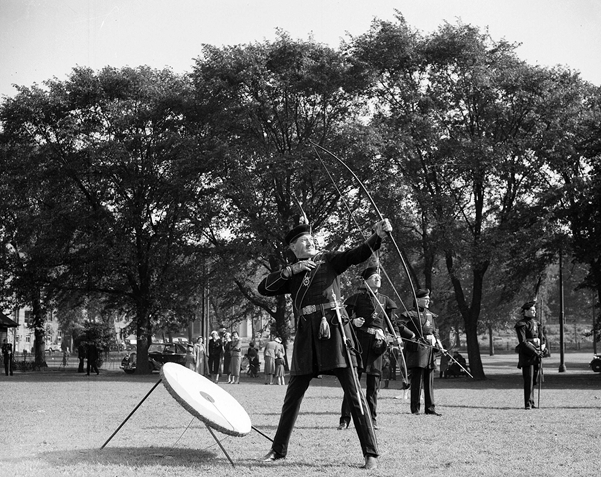The Royal Company’s Regulations of 1676 required Archers to:
‘. . . be holden to appear, with sufficient shuting graith, carrying the Company’s Seal and Arms in their Hatts or Bonnetts, as their Badge and proper Cognizance, and shall be fitted in such other equipage and order.’
‘Graith’ is the old Scots word for, amongst other things, ‘armour, accoutrements of war, specifically of an archer’. The word is still used in The Royal Company.

An Archer’s graith has changed very little over the years. One of the most prized objects in the Royal Company’s magnificent Collection is the Flodden Bow. The provenance of the bow strongly suggests that it was used at Flodden Field in 1513 and so it is likely to be over 500 years old. The longbows used by the Royal Company today are almost identical in design, construction and capability to the Flodden Bow.
The Bow
The best bow was traditionally made of yew, just as the Flodden Bow was fashioned over 500 years ago. Over the years, good yew has become increasingly difficult to obtain and bows are now often made of laminates of different wood types. Whilst the Flodden Bow is made from a single yew stave, most modern bows are made from two similar staves spliced together under the handle. The length of the bow is typically around 6 feet (or 1.8 metres).
The strength of a bow is measured in pounds (lbs), representing the amount of weight that would be required to fully extend the bow if the weight were to be suspended from the bowstring. A comfortable draw weight for a beginner would be 35 to 50 lbs, measured at a 27 to 28 inch draw length. It has been estimated that the strength of the Flodden Bow would have been 80 to 90 lbs.
Bowstrings were traditionally made from sinew, twisted rawhide, gut, hemp, flax or silk but today they are more often made of Dacron fibre. The string is slotted into grooves carved into protective horn “nocks” at either end of the bow.
Bows require little maintenance but care must be taken to avoid excessive heat in order to preserve the natural moisture levels in the wood.
The Royal Company employed a professional full-time bowmaker (or bowyer) until 1970 but now relies on a highly skilled group of traditional bowmakers and fletchers from across Britain.
The Arrows
Arrows today are normally 28 or 29 inches long and are stabilised by three feathered fins. Arrows have traditionally been made of solid shafts of wood such as pine, spruce, ash, elm, willow or oak. The feathers, most commonly those of turkeys, cause the arrow to spin in flight thus steadying its path. Arrowheads were once made of flint, bone, horn, bronze or hardwood but are now commonly made of brass or steel. Archers mark their graith with initials or family colours in order to ensure recognition (and recovery) in competitive shooting.
